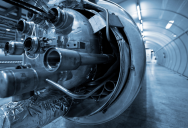Unexpected Results From A Recent Experiment At The Large Hadron Collider Suggest A Potential Flaw With The Standard Model Of Physics

When studying the smallest particles that make up our world, the Large Hadron Collider at CERN is quite possibly the best place to do it. During an experiment called NA62, researchers were able to detect a form of decay for a subatomic particle known as a kaon, which is believed to be extraordinarily rare.
So rare that scientists estimated that it would happen fewer than once out of every ten billion kaons. This estimate is based on the standard model that is used, which a growing number of people are calling into question.
The fact that this was able to be observed is quite remarkable. It was done by using CERN’s Super Proton Synchrotron to send a beam of protons into a stationary target. This would then eject secondary particles, which would include kaons. These kaons could then be measured and observed by the highly specialized equipment to see what type of decay they experienced.

Interestingly, during the experiment, the kaons were observed to go through the ultra-rare type of decay 13 times out of 100 billion, which is significantly more frequently than was previously expected.
Of course, this could be due to random chance or some other factors that will need to be studied and determined. If this experiment is repeated and replicated, however, it would indicate that the standard model of physics is flawed in some way.
In a statement, Karim Massri, who is the physics coordinator for NA62, said:
“Searching for hints of new physics in this decay requires more data, but this result is a leap forward and further strengthens the strong interest in this line of research.
These types of unexpected results are often what can drive the understanding of complex subjects like this forward. It will undoubtedly require additional experiments and study to determine what all this means.

The particle accelerator at CERN continues to amaze.
If you thought that was interesting, you might like to read about why we should be worried about the leak in the bottom of the ocean.

Sign up to get our BEST stories of the week straight to your inbox.




